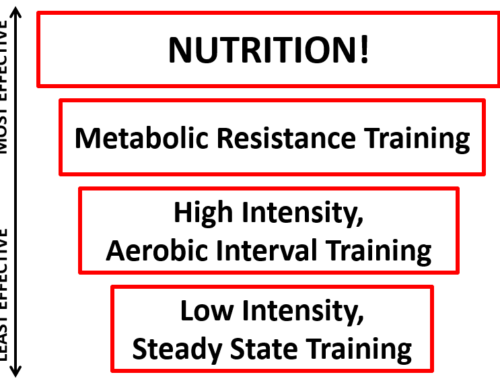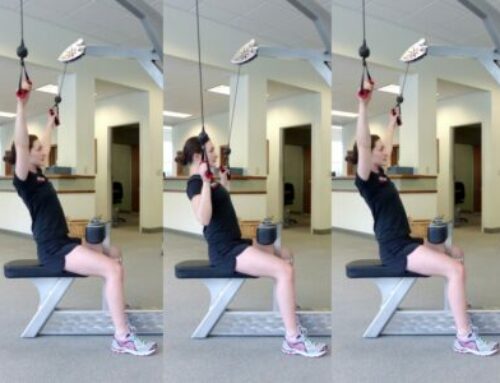Cardio training (a generic term that refers to any aerobic type exercise) is an important part of anyone’s exercise plan…and for good reason. The benefits of this style of training are numerous. It…
- strengthens the respiratory muscles
- improves the heart’s pumping efficiency
- reduces resting heart rate
- improves circulation efficiency
- reduces blood pressure
- burns body fat (an all-time favorite!)
Any physical activity that gets your heart rate up and keeps it up for an extended period of time qualifies as cardio training and can elicit the above-mentioned benefits. However, if not done progressively, our bodies will begin to adapt and we will experience a diminished return on our cardio training. This is due to the fact that, over time, our cardio-vascular, cardio-respiratory and muscular systems become very efficient with the task they’ve been given, resulting in improved fuel-efficiency. That’s right. Unlike our cars, which tend to lose performance efficiency the more we run them, our bodies actually improve.
Here is how to get the most out of your training:
Be purposeful with your cardio training time…
One big advantage to cardio training is that it is simple…it involves very little thinking or training expertise. Because of its simplicity, it is easy to lose focus and just go through the motions. To get the most out of your training, have a specific plan going into it.
Monitor your intensity…
As mentioned above, it is easy to “fuzz out” during cardio training. For some, heart rate monitor wristwatches are helpful, but for most of us, a simple assessment of perceived exertion will suffice. Ask yourself, “on a scale of 1-10, how hard am I working?” If you’re supposed to be working at a “7-8” on a scale of 1-10 or 75% max effort, you should feel like you can maintain that intensity for no more than 30 minutes. If you’re cruising along and feel like you can go for an hour, you know you’ve got to pick it up! Keep in mind that you’re monitoring your intensity, not the setting on the machine. With a properly designed cardio program, you may need to bump up the settings (mph and grade on a treadmill, rpms and resistance on a bike, for instance) to elicit the desired response by the body.
Work hard…
Although it is true that we “burn” relatively more fat with lower intensity cardio training (55% – 65% of max functional capacity), the absolute amount of fat we use is actually less than if we were to work at a slightly higher intensity (75%-85% of max functional capacity). If burning calories is the goal of the cardio training session, we shouldn’t be as concerned about the fuel utilization during the session as compared to the fuel utilization after the session (EPOC).
Keep your body guessing…
Let’s say you get 2-3 cardio workouts per week. If you always give your body the same stimulus on the same days, you will quickly adapt and probably not get the desired result.
At One on One, we’ve created endurance training protocols that will help keep your body guessing:
The 2-Minute Buildup
Earlier, we mentioned fuel efficiency. We know that cars are much more efficient running at a consistent speed on the highway. Fuel efficiency goes way down with the starts and stops of driving in traffic. Unless you are training for an endurance event, we don’t want our bodies to become efficient with our cardio training. The 2-Minute Buildup allows you to train for a long-duration, but with a progressive system of increasing intensity. Every two minutes, increase the intensity from approximately 60% of perceived max effort, to 70% to 80%, then back to 60% and start over.
Interval Training
Interval Training involves bursts of high-intensity work interspersed with periods of low-intensity work. The high-intensity periods are typically at or close to near-maximum exertion, while the recovery periods may involve either complete rest or activity of much lower intensity. The duration of Interval Training workouts, as well as the time ratio of work/rest depends on the individual’s fitness level and training objectives. This format is especially helpful when training for specific events, such as a 5-K.
The Sprint Workout
This format gives you 2 1/2 minutes to work at 55%-65% of max effort, followed by an all-out 90%-95% effort for 30 seconds. You will definitely need the two and a half minutes to recover prior to sprinting again. We love this workout at One on One. In thirty-minutes, you get 10 cycles of sprint/recover. Talk about affecting EPOC, burning post-workout calories and maximizing your time exercising!
Save your Joints
One final tip on optimizing your cardio training; research shows that although the health and fitness benefits of cardio training are numerous, too much of the same type of training can quickly lead to overuse injuries. Using different formats, modifying your weekly schedule and monitoring your intensity is the ultimate in cross training.
Be purposeful with your training and you can expect a lifetime of good cardiovascular health and a healthy body composition. Be sure to talk with your trainer this week to make sure your cardio training program is on track!
Copyright 2011 Fitness Consultants Inc. All rights reserved.




